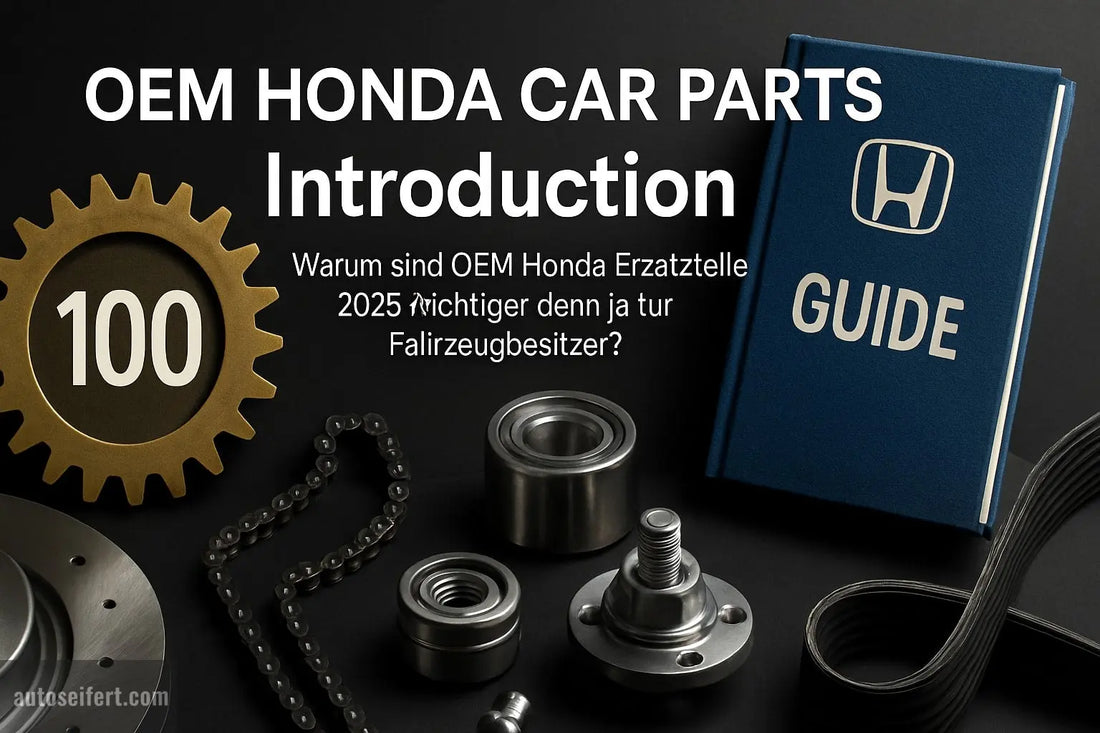
Oem Honda Car Parts Guide: Expert Tips for 2025
Share
OEM Honda car parts are more important than ever for vehicle owners in 2025. Those who value quality, safety, and value retention should understand the differences between aftermarket parts and focus on genuine parts.
Choosing the right parts will save you time, money, and avoid unnecessary stress. This guide will show you how to find, select, and install genuine Honda car parts.
Look forward to expert tips, practical selection criteria and an outlook on future trends in OEM Honda spare parts.
What are OEM Honda car parts?
Originality is essential for many Honda drivers. But what makes OEM Honda car parts so special and how do they differ from other aftermarket parts? Below, you'll learn why these components are crucial for your vehicle's reliability and value retention.
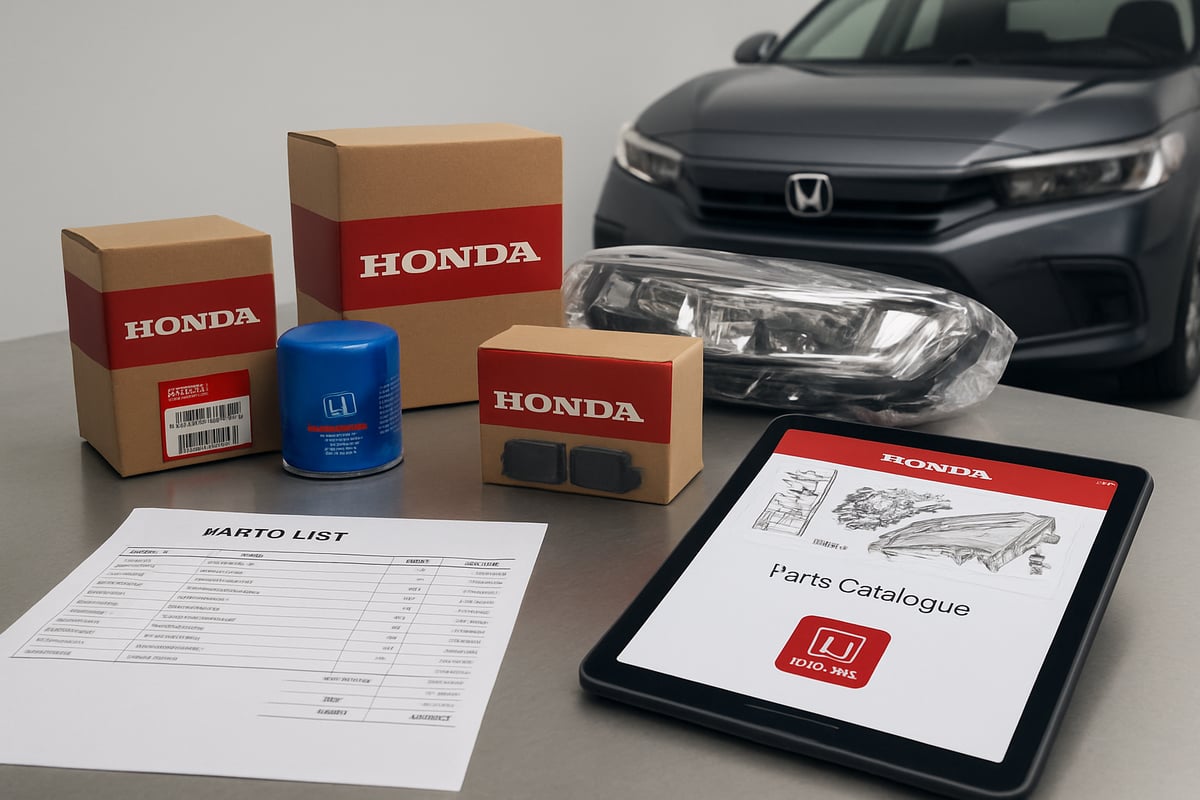
Definition and differentiation from aftermarket parts
OEM stands for "Original Equipment Manufacturer" and describes parts produced directly by the manufacturer or its suppliers. In the context of OEM Honda car parts, this means that these replacement parts meet exactly the specifications and quality standards specified by Honda for the original delivery condition.
In contrast, aftermarket parts come from third-party manufacturers. They are often cheaper, but can vary in terms of fit, material quality, and durability. Most importantly, only OEM Honda car parts offer you a full manufacturer's warranty and proven safety.
Comparison table: OEM vs. aftermarket
| criterion | OEM Honda parts | Aftermarket parts |
|---|---|---|
| quality | Factory standard | Fluctuating |
| Accuracy of fit | 100% | Variables |
| Guarantee | manufacturer warranty | Often no/limited |
| price | Higher | Cheaper |
A practical example: A original Honda oil filter provides optimal protection for the engine, while an aftermarket filter is often less efficient. These differences can be crucial to the longevity of your engine in the long run.
Benefits of OEM parts for Honda vehicles
Using OEM Honda car parts brings numerous advantages. First, production according to factory standards guarantees the highest levels of safety and reliability. Every part is subject to strict quality controls and is TÜV-compliant. This means a lower risk of breakdowns or consequential damage.
Another advantage is their longer service life. OEM parts are precisely engineered and tuned for your Honda model. They offer optimal performance, which translates into shorter braking distances and smoother engine operation, for example.
Your vehicle's value also benefits: With OEM Honda car parts, the manufacturer's warranty remains intact, which is a decisive factor, especially when reselling. According to a 2023 industry survey, 68% of Honda owners prefer genuine parts because they value durability and safety.
Last but not least, you'll save time and money in the long run. The high level of precision fit eliminates the need for rework, and you avoid subsequent costs due to improper repairs. Investing in OEM Honda car parts pays off many times over.
Typical OEM Honda spare parts
Which OEM Honda car parts are in high demand? Typical wear parts include brake pads, brake discs, oil filters (e.g., 15400-PLM-A02 for many gasoline engines), air filters, and spark plugs. These components are essential for maintenance and should be replaced at regular intervals.
In the body department, bumpers, exterior mirrors, and headlights are frequently required parts. For the 2016-2021 Honda Civic, for example, the headlight with part number 33150-TBA-A01 is a typical replacement part.
Electronic components are also playing an increasingly important role. These include sensors, control units, and specific wiring harnesses, such as the exhaust gas temperature sensor for the Honda CR-V 2.2 i-CTDi with part number 37811-R07-E02.
Given Honda's wide range of models, it's always worth taking a look at the parts catalog to find the right OEM Honda car parts for your vehicle. This ensures value retention, safety, and driving pleasure at the highest level.
How to find the right OEM Honda parts for your model
Selecting the right OEM Honda car parts for your vehicle requires precision and care. By taking the right steps, you can avoid mistakes and ensure your Honda remains reliable. Follow this guide for a targeted and efficient approach.
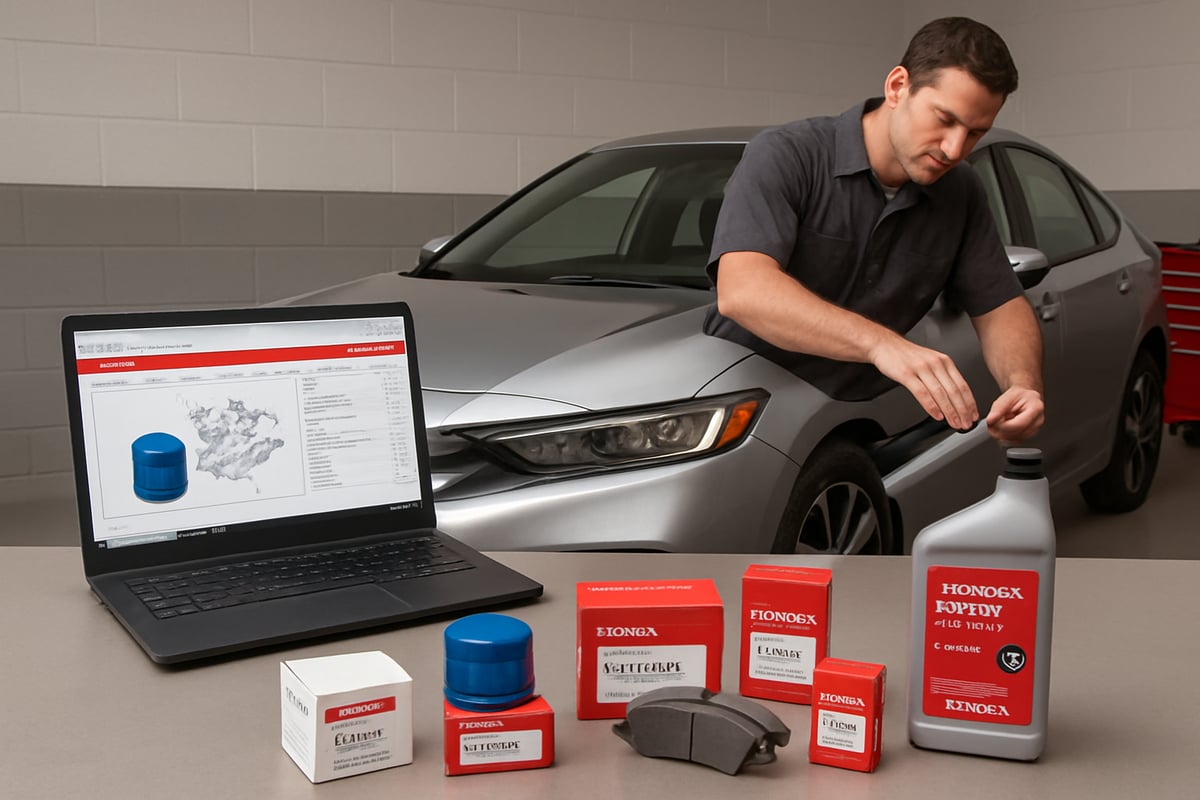
Step 1: Identify vehicle data and part numbers
The first and most important step in finding the right OEM Honda car parts is to accurately identify your vehicle. To do this, use the vehicle identification number (VIN), which you can find on your vehicle registration document or directly on the vehicle. The VIN contains all relevant information such as model year, engine type, and trim levels.
Using this information, you can conduct a targeted search in the Honda parts catalog. Many online tools offer a VIN query to help you find the right parts. Make a note of the exact part numbers, as even small differences between model years can be crucial.
Example: For a 2018 Honda CR-V with a 1.5 VTEC engine, you need different OEM Honda car parts than for a 2015 diesel CR-V. Carefully checking the vehicle specifications will protect you from incorrect deliveries and facilitate future queries.
Step 2: Identify reputable sources
Choosing the right supplier is crucial for obtaining genuine OEM Honda car parts. Authorized workshops offer proven quality, while specialized online shops often offer a larger selection and better prices.
Pay attention to certificates, original packaging, and holograms to avoid counterfeits. Customer reviews are a valuable tool: Read authentic experiences before you order. You can find an overview, for example, at Customer reviews of Honda parts.
Also, check the shop's reliability by looking for quality seals and transparent return policies. This will protect your investment and avoid disappointment when ordering OEM Honda car parts.
Step 3: Price comparison and delivery times
A thorough price comparison will help you save money on OEM Honda car parts without sacrificing quality. Keep in mind that OEM parts are on average 20 to 40 percent more expensive than aftermarket products, but offer a longer lifespan.
Use online price comparison portals and pay attention to delivery times. Retailers with local warehouses often deliver faster than direct shipping from abroad. Calculate shipping costs and check return options if the parts don't fit.
| Part | OEM price (€) | Aftermarket price (€) | Durability (km) |
|---|---|---|---|
| brake pads | 90 | 65 | 40.000 |
| oil filter | 22 | 14 | 15.000 |
| air filter | 32 | 20 | 20.000 |
So you can see that the higher price for OEM Honda car parts is often offset by less wear and less frequent replacement.
Step 4: Use advice and support
Even experienced car owners benefit from professional advice when selecting the right OEM Honda car parts. Many suppliers offer technical support via phone, email, or WhatsApp.
- Clarify any open questions regarding part identification
- If you are unsure, seek advice
- Use online chat functions for quick help
Expert advice will help you avoid ordering incorrect parts and select the right parts for your Honda model. Have your vehicle data ready to expedite the process. Consulting experts is especially advisable for complex parts such as control units or sensors.
[autoseifert.com – Your partner for original Honda parts] (https://autoseifert.com)
autoseifert.com is your reliable partner when it comes to OEM Honda car parts. The shop offers Europe-wide shipping and a wide selection of original parts for cars and motorcycles.
The advantages at a glance:
- Direct contact with Honda experts
- Personal advice and fast delivery
- Extensive range for all common models
- Excellent customer reviews and transparent processes
A practical example: A Honda Civic owner from Austria orders an oil filter from autoseifert.com and receives the right part within 48 hours. This saves you time and guarantees you receive genuine OEM Honda car parts for your vehicle.
Installing OEM Honda parts correctly: Expert tips for 2025
Installing OEM Honda car parts requires careful preparation, technical expertise, and the utmost precision. This is the only way to ensure your Honda remains reliable and safe in the long run. With the following expert tips, installation in 2025 is guaranteed to be stress-free.
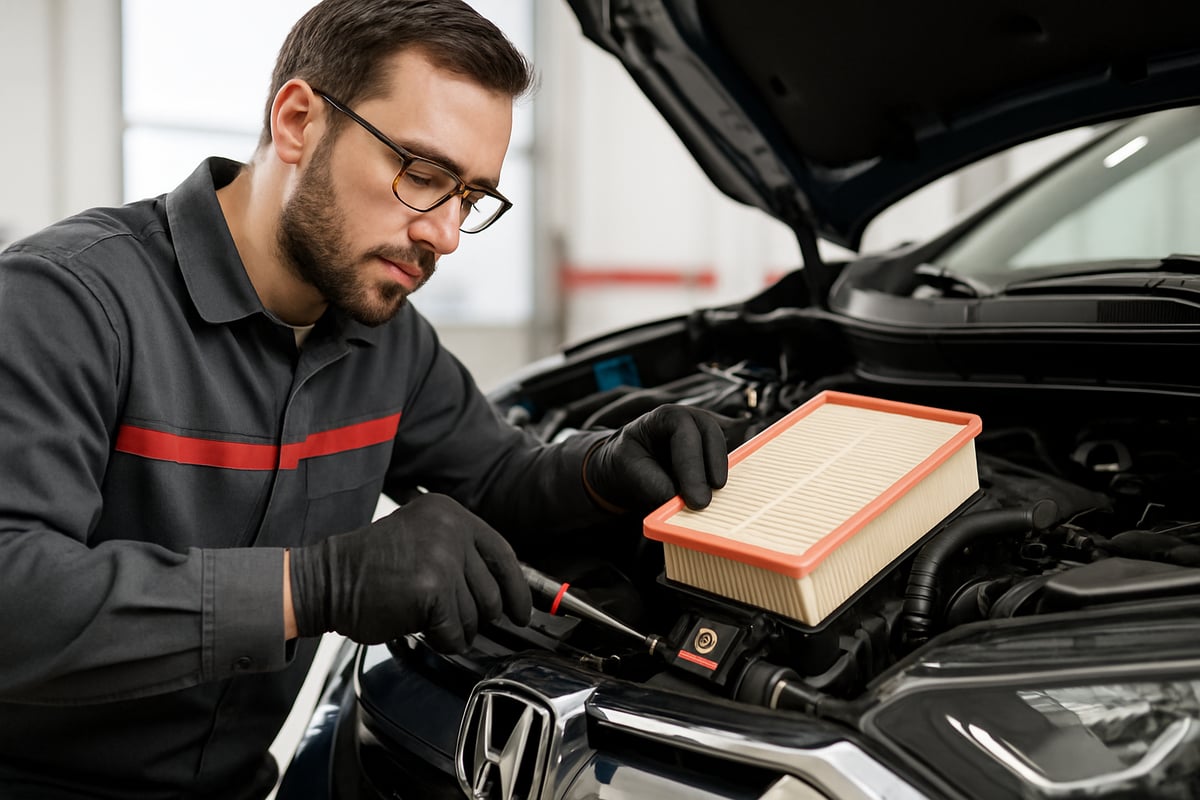
Preparation: Tools, workplace and safety
Before you begin installing OEM Honda car parts, thorough preparation is crucial. Gather all the necessary tools. This includes wrenches, torque wrenches, pliers, and any special Honda tools.
Maintain a clean and well-lit workspace. A tidy environment prevents small parts from getting lost or mistakes being made. Organize all OEM Honda car parts clearly to avoid unnecessary search time.
Don't forget safety. Always wear protective gloves and goggles to prevent injuries. Especially when working in the engine compartment, cuts or eye damage from dust and oil can easily occur.
Step-by-step instructions for installing common parts
The precise installation of OEM Honda car parts such as air filters, brake pads, or sensors follows clear steps. Let's take replacing an air filter in a Honda CR-V as an example: First, open the hood and carefully remove the old filter element. Insert the new original part precisely, making sure all seals are properly seated.
When tightening bolts and nuts, always use the torque specified by the manufacturer. This prevents parts from being damaged or installed too loosely. Certain OEM Honda car parts require special Honda tools or adapters to ensure precise installation.
A comprehensive overview of all available original parts and their installation instructions can be found in the Honda Genuine Parts OverviewThis way you can be sure that you always choose the right spare part for your model.
Sources of error and how to avoid them
Even experienced mechanics occasionally make mistakes when installing OEM Honda car parts. Common causes include using the wrong part, improper installation, or forgetting seals and retaining rings.
Always check the part number before installation and compare it with your vehicle registration document. Use checklists to systematically complete all installation steps. Perform a functional test after installation to identify potential problems such as loss of power or error messages early on.
Installation errors can lead to expensive consequential damage, such as engine failure or the failure of critical safety systems. Therefore, care and patience are essential when dealing with OEM Honda car parts.
When is a professional needed?
Not every installation of OEM Honda car parts should be done on your own. Complex repairs, such as replacing the timing chain or working on the control unit, belong in the hands of experienced specialists. A visit to a certified Honda workshop is also advisable when working on the vehicle electronics or high-voltage systems of current hybrid and electric models.
Another important point: Only installation by a specialist workshop ensures the full validity of your manufacturer's warranty. In 2025, new regulations regarding workshop commitment and the documentation of service work will also come into effect. Therefore, always check which work you are permitted to perform yourself and when it's better to seek professional help.
The most important OEM Honda spare parts for 2025 at a glance
The selection of OEM Honda car parts in 2025 is more diverse than ever before. For vehicle owners, it's crucial to know the most important spare parts to ensure efficient maintenance and repairs. Which parts are in high demand and which trends are shaping the market? This overview provides essential information on the top components, technical innovations, compatibilities, and accessories.
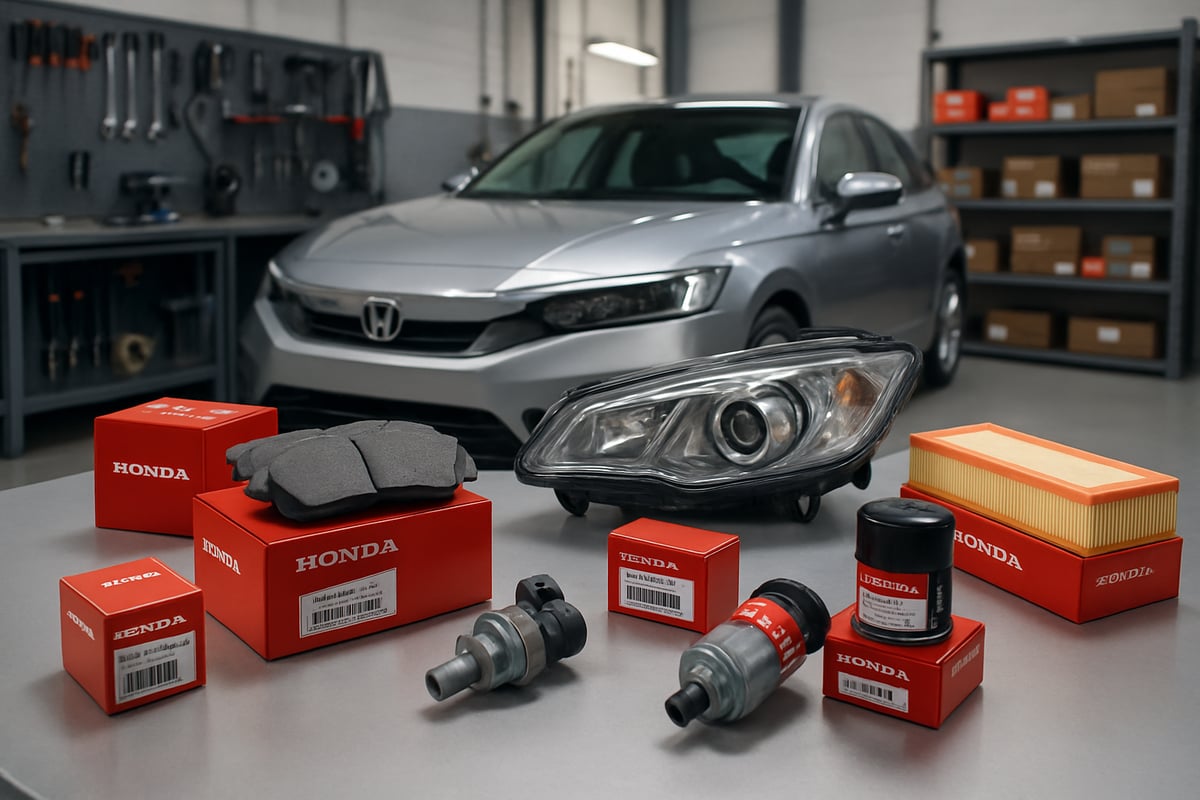
Top 5 wear parts with high demand
In 2025, some OEM Honda car parts will be in particular focus, as they require regular replacement and directly contribute to driving safety. The best-selling wear parts are:
- brake pads
- brake discs
- oil filter
- air filter
- Spark plug
A recent industry survey shows that these components play a role in over 70% of Honda workshop visits. Brakes and filters not only ensure safety but also optimal engine performance. Spark plugs ensure reliable engine starting and efficient combustion.
| Part | Model example | Typical part number |
|---|---|---|
| brake pads | Civic, CR-V | 45022-T1G-E01 |
| brake discs | Jazz, Accord | 45251-TF0-E01 |
| oil filter | Civic, HR-V | 15400-PLM-A02 |
| air filter | CR-V, Jazz | 17220-5R0-008 |
| Spark plug | Civic, Accord | 12290-R70-A01 |
Those who rely on these OEM Honda car parts in a timely manner can avoid expensive consequential damage and increase the service life of the vehicle.
New technologies and trends in Honda spare parts
The next generation of OEM Honda car parts is characterized by electronics and sustainability. Modern vehicles require more and more sensors and control units. Components for driver assistance systems and precise sensors such as the Honda Genuine Exhaust Temperature Sensor CR-V, which ensures correct exhaust gas control.
With the rise of hybrid and electric mobility, spare parts such as battery management systems and high-voltage components are gaining in importance. Manufacturers are increasingly relying on recyclable materials and low-CO2 production. These trends are also reflected in the rising demand for sustainable OEM Honda car parts that are not only environmentally friendly but also high-performance.
Cross-model compatibility
Many OEM Honda car parts are compatible with multiple models. This simplifies inventory management and reduces costs for customers. For example, certain brake systems fit both the Honda Civic and the Jazz. Air filters and sensors are often compatible across models, as long as the part numbers match.
Compatibility increases flexibility in repairs and maintenance. For owners of different models, this means less effort in sourcing parts and greater security in always getting the right original part. Those familiar with OEM Honda car parts save time and minimize the risk of ordering incorrect parts.
Original accessories vs. tuning parts
In addition to classic OEM Honda car parts, there is a wide range of genuine accessories. These include floor mats, roof racks, and alloy wheels developed specifically for Honda models. These accessories offer a perfect fit and are TÜV-compliant.
In contrast, tuning parts often carry a warranty risk because they don't always meet the manufacturer's specifications. Original accessories are optimally tailored to the vehicle and ensure value retention. Those who rely on OEM Honda car parts and matching accessories benefit from safety and functionality – a decisive advantage over aftermarket parts.
Tips for sustainable and cost-effective handling of OEM Honda parts
The sustainable and cost-effective use of OEM Honda car parts will become increasingly important for vehicle owners in 2025. A well-thought-out strategy can not only reduce maintenance costs but also protect the environment and the value of your vehicle. Here you'll find practical tips on how to make the most of genuine parts and reap long-term benefits.
Maintenance intervals and proactive parts procurement
Regular maintenance is key to your vehicle's longevity. Follow the manufacturer's recommended service schedules and replace OEM Honda car parts like brake pads, filters, and spark plugs on time. This will prevent expensive consequential damage and maintain the value of your Honda.
Build up a small stock of frequently used OEM Honda car parts, especially if you use your vehicle intensively. This way, you'll be able to take immediate action in the event of a defect and avoid extended downtime. Use parts catalogs and digital service apps to identify needs early and order the right parts.
Save costs with OEM parts
Many vehicle owners wonder whether the extra cost for OEM Honda car parts is worth it. The answer: Yes, in the long run, you save money thanks to their longer service life and lower failure rates. While cheap replicas often wear out faster, original parts impress with their quality and precise fit.
A five-year comparison shows that OEM Honda car parts often result in lower overall costs. You avoid repeated repairs and consequential damage that can occur with inferior alternatives. Calculate costs in advance to maximize your budget and avoid unnecessary expenses.
Environmentally conscious action
Sustainability is becoming increasingly important when dealing with OEM Honda car parts. Make sure to dispose of old parts properly or have them recycled. Many dealers offer take-back systems for used parts to reclaim valuable raw materials.
Whenever possible, rely on remanufactured original parts to conserve resources. The market for remanufactured car parts is growing steadily, as the Market size for remanufactured auto parts This impressively demonstrates. Environmentally friendly packaging and low-carbon shipping options also contribute to sustainable parts management.
Used OEM parts: opportunities and risks
Buying used OEM Honda car parts can be a cost-effective alternative, but it carries risks. Carefully check the condition and origin of the parts. Reputable suppliers will provide information about mileage, age, and any warranty claims.
Avoid used wear parts like brakes or filters, as their lifespan is difficult to estimate. When it comes to bodywork or electronic components, purchasing them can be a good idea if they have been professionally inspected. This way, you can take advantage of used OEM Honda car parts without any unpleasant surprises.
Tips for online shopping in 2025
When purchasing OEM Honda car parts online, you should pay attention to reliability and safety. Use only certified dealers with good customer reviews and clear return policies. Check the original packaging and look for holograms as proof of authenticity.
Use secure payment methods and pay attention to data protection. The OEM Auto Parts Manufacturing: Key Components of the Sector, which explains what to look for in genuine OEM parts. With a checklist for the ordering process, you can minimize the risk of incorrect purchases and counterfeits.
Future Outlook: OEM Honda Spare Parts and Trends 2025
The world of OEM Honda car parts is undergoing a transformation. Digital innovations, sustainability, and new vehicle technologies will shape the aftermarket in 2025. Vehicle owners benefit from more efficient processes, but challenges such as supply bottlenecks and regulatory changes are also increasing.
Digitalization in the spare parts trade
Digitalization is revolutionizing the trade in OEM Honda car parts. Online platforms offer comprehensive parts catalogs that filter specifically by chassis number. Augmented reality allows users to access step-by-step instructions directly on the vehicle.
Honda relies on e-service apps that enable rapid parts identification. Workshops save time, while customers benefit from greater transparency. Digital interfaces seamlessly connect dealers, workshops, and end users. The result: more efficient procurement and fewer errors when purchasing parts.
Sustainability and circular economy
Sustainability is also a focus at OEM Honda car parts. OEM manufacturers are investing in environmentally friendly production processes and increasingly relying on recyclable materials. Instead of replacement, many vehicle owners prefer repairs with original parts to conserve resources.
A circular economy means that used parts can be returned to the market after being inspected. Honda supports initiatives that professionally remanufacture old components. This reduces waste and lowers costs for consumers in the long run.
Electrification and new vehicle technologies
With the boom in hybrid and electric vehicles, the demand for specialized OEM Honda car parts is increasing. New technologies such as high-voltage batteries or complex control units require specialized expertise in spare parts service.
Workshops must prepare for new challenges, such as the safe disassembly of battery components. Honda's market share of new car registrations in the EU shows that the demand for suitable spare parts for modern models continues to grow. Model diversity is also increasing, which influences the selection and availability of spare parts.
Supply chains and availability 2025
Global supply chains are under pressure, affecting the availability of OEM Honda car parts. Raw material shortages, transportation issues, and geopolitical developments are leading to price fluctuations and longer delivery times.
According to the US Aftermarket Auto Parts Market Report Retailers are responding with local warehousing and more flexible procurement strategies. Forecasts indicate that electronic components, in particular, could become scarce. Customers should therefore order parts early and rely on proven sources.
Legal changes and impact on the spare parts market
New EU directives will come into force in 2025, which will also affect the OEM Honda car parts market. Stricter product safety and warranty requirements will increase the demands on dealers and workshops.
Labeling requirements ensure greater transparency when purchasing parts. Dealers must provide detailed information on origin and compatibility. For vehicle owners, this means greater safety, but also the need to regularly check current regulations.
